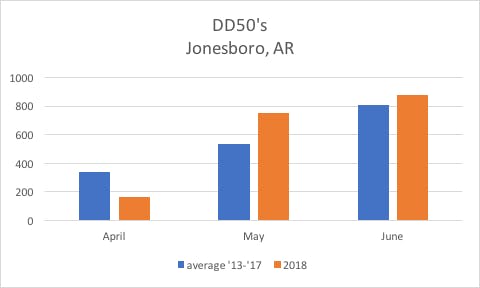Applying Lessons Learned From 2018's Challenges
The official Groundhog Day is just a couple of weeks away; however, this winter has seemed like a live rendition of the movieGroundhog Day. Brief stretches of sunshine have been enveloped by seemingly endless stretches of clouds and rain. Each day of rain, right now, adds to my personal worry because there is a lot of work to do and a shorter and shorter time to get it done to move into 2019 planting.
A good friend told me one time that worry is interest paid on a debt I may never owe. I often have reminded myself and my team that the crop always gets planted. Assuming this year is like previous years, we will plant rice in 2019. We cannot control the weather, but we can control our planning for when the weather cooperates, and we can prepare for planting.
It has been said that those who don’t learn lessons from history are doomed to repeat it. In many ways, 2018 was a great teacher. The question each must ask is, “What did we learn?” Before planting in 2019, I’d like to remind you of gleanings from 2018 to hopefully help us minimize the same mistakes this season.
Timing is everything. Timing was the biggest enemy of record-setting yields in 2018. The weather as a whole from mid-April through grain maturity was very favorable for achieving very high, if not record-setting, yields. What were the limiting factors? Weed control has to be one at or near the top. Red rice, barnyardgrass, and sprangletop are highly competitive with the three major rice types grown in the Southern United States (semi-dwarf, conventional-statured and hybrid). In a study conducted in Arkansas and published in 2007, all rice types lost approximately 1.3 bushels per acre for every percent of barnyardgrass control that was not obtained. The lack of grass control alone could have, at a minimum, cost 10-15 bushels per acre on a substantial number of acres throughout the South in 2018.

Nitrogen fertilizer efficiency was compromised in multiple ways. First, one of the reasons grass is so competitive is that it competes for nutrients such as N. Second, rice is a DD50 crop, and the more DD50s that are accumulated per day, the less time it takes to reach the next growth stage. Because of the excessively hot May and June, rice reached preflood and midseason fertilization stages much sooner than normal. This was compounded by the fact that it was more difficult to establish floods in a timely manner. Nitrogen fertilizer is not plant-available until it is incorporated into the soil by rain or irrigation. Many rice acres in 2018 reached green ring or beyond before N fertilizer was incorporated. Yield potential is largely set in the vegetative growth stage; therefore, we substantially sacrificed yield.
General Concepts for 2019
Start clean and stay clean. Back to “Groundhog Day”: Wet weather moved in earlier than normal, and many fields were left rutted from the 2018 harvest. Substantial field work has to be done prior to rice planting in 2019. The deeper tillage that will be necessary will certainly have consequences. One consequence we should be prepared to deal with is bringing new seed to the surface. Red rice and grasses will have the opportunity to germinate and wreak havoc in 2019 if not addressed early and often.
In my experience, the best way to control grass is to never let it emerge. Horizon Ag Clearfield® rice varieties will allow for another residual mode of action to be used as a pre-emergent. Newpath® herbicide or Clearpath® herbicide in addition to clomazone behind the planter is a very good way to start clean. To stay clean, Prowl herbicide, thiobencarb and/or more Newpath herbicide can be applied before the first residuals break. Overlapping residuals is key.
Nitrogen management strategies are critical.
Nothing has changed in that the drill-seeded, delayed-flood system gives us the opportunity to have one of if not the most efficient systems for high nitrogen uptake and utilization efficiency. Getting N applied at the right time at the right rate while using the right source is only half the battle. The other half is making sure other nutrients like P, K, Zn and S are not limiting and that the N is incorporated and protected by timely flood management. The temptation in tight financial years is to skip or greatly reduce “mixed fertilizer.” You won’t maximize your return on your N investment if any other nutrient is limiting.
Horizon Ag understands the financial challenges the industry faces. We have excellent rice seed products that can help on many of the acres that will be planted to rice in 2019. Furthermore, we are fortunate to be partnered with BASF in our efforts to help cash flow in 2019 with our zero percent financing plans through December 2019 offered through John Deere Financial and Rabo AgriFinance.
Other limitations may apply. See full program terms and conditions for further details. Credit subject to approval by Rabo AgriFinance. Must be Rabo AgriFinance authorized retailer. Qualifying transactions must be submitted for payment by the program dates in order to receive the corresponding interest rate. Offer valid on qualifying purchases made between 1 October 2018 to 30 September 2019. John Deere Credit offer limited to Multi-Use Account Agricultural customers with an available Special Terms Credit Limit. Subject to the Multi-Use Account credit agreement and approval. Fixed 0% APR from the date of purchase, which may be prior to delivery, until December 2019, when the entire transaction amount is due in full. The principal balance, accrued interest, and all finance charges associated with the purchase are due in full on the customer's December 2019 statement due date. Regular Multi-Use Account rates will apply after that date. Offer may be limited to qualifying products. No minimum purchase required. Subject to merchant participation, see your local merchant for complete details. Multi-Use Accounts are a service of John Deere Financial, f.s.b.
